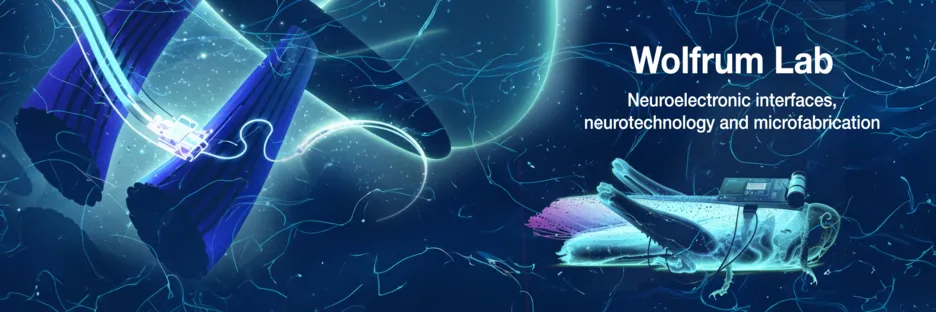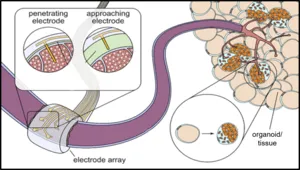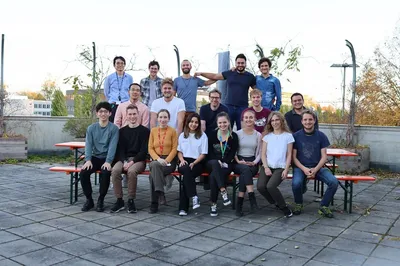
The Neuroelectronics group develops biocompatible interfaces and sensor arrays for coupling tissue with electronics.
We design and fabricate bioelectronic interfaces and electrode arrays for neurotechnology and biosensors. In particular, we develop devices capable of stimulating and monitoring signals in neural or cardiac tissue. To this end, we use clean-room microfabrication, laser processing, and printing techniques for prototyping 3D transformable electrode arrays with soft, flexible, and biocompatible materials.
Our applications focus on neural implants, non-invasive bioelectronics, and in vitro assays for investigating organoids and microfluidic cell culture systems. Recently, we have developed neuroelectronic devices that actively conform to the tissue structure's shape. Our devices can fold themselves around small peripheral nerves and provide a reliable connection to the tissue. This allows spatially and temporally resolved recording of electrophysiological signals along the nerve. At the same time, the nerve can be electrically stimulated to elicit a specific response of the innervated tissue. Using rapid prototyping techniques, we further develop 3D sensor systems that can be coupled with neuronal or cardiac organoids in a high-throughput manner. For example, micro-needle electrode arrays provide a means for continuously monitoring electrical activity within deeper layers of 3D cell assemblies. Overall, we aim to deliver long-term stable bioelectronic interfaces that can be used for closed-loop bidirectional communication and seamlessly integrate with the target tissue or organoid system. We complement these approaches with electrochemical and impedance-based detection strategies for biosensing applications.
The Neuroelectronics group has collaborations with several partners from academia and industry, including research groups at TUM, Forschungszentrum Jülich, TU Dresden, Tohoku University, ETH Zürich, IIT Kharagpur, University of Bologna, University of South Australia, and NTT Research Laboratories. We are located in the facilities of the Munich Institute of Biomedical Engineering and the Central Electronics and Information Technology Laboratory (ZEITlab) of the TUM School of Computation, Information and Technology.
Prof. Dr. Bernhard Wolfrum
Full team can be found here.
4D‐Printed Soft and Stretchable Self‐Folding Cuff Electrodes for Small‐Nerve Interfacing. L. Hiendlmeier, F. Zurita, J. Vogel, F. Del Duca, G. Al Boustani, H. Peng, I. Kopic, M. Nikić, T.F. Teshima, B. Wolfrum*. Advanced Materials (2023)
Aerosol Jet-Printed High-Aspect Ratio Micro-Needle Electrode Arrays Applied for Human Cerebral Organoids and 3D Neurospheroid Networks. S. Zips, B. Huang, S. Hotte, L. Hiendlmeier, C. Wang, K. Rajamani, O. Buriez, G. Al-Boustani, Y. Chen*, B. Wolfrum*, A. Yamada*. ACS Appl. Mater. Interfaces (2023)
Printed silk microelectrode arrays for electrophysiological recoding and controlled drug delivery. N. Adly, T.F. Teshima, H. Hassani, G.A. Boustani, L.J.K. Weiß, G. Cheng, J. Alexander, B. Wolfrum*. Advanced Healthcare Materials (2023)
Origami-Enabled Stretchable Electrodes Based on Parylene Deposition and 3D Printing. F. Del Duca, L. Hiendlmeier, R. Al Fata, G. Al Boustani, I. Kopic, H. Peng, B. De Chiara, M. Nikić, F. Zurita, T. Teshima, B Wolfrum*. Advanced Electronic Materials (2023)
Fully 3D-Printed Cuff Electrode for Small Nerve Interfacing. F. Zurita, L. Grob, A. Erben, F. Del Duca, H. Clausen-Schaumann, S. Sudhop, O. Hayden, B. Wolfrum*. Advanced Materials Technologies (2023)
Filtration-processed biomass nanofiber electrodes for flexible bioelectronics. D. Ando, T.F. Teshima, F. Zurita, H. Peng, K. Ogura, K. Kondo, L. Weiß, A. Hirano-Iwata, M. Becherer, J. Alexander, B. Wolfrum*. Journal of Nanobiotechnology (2022)
A Superabsorbent Sodium Polyacrylate Printing Resin as Actuator Material in 4D Printing. L. Hiendlmeier, T.F. Teshima, F. Zurita, H. Url, P. Rinklin, B. Wolfrum*. Macromolecular Materials and Engineering (2022)
Prototype Digital Lateral Flow Sensor Using Impact Electrochemistry in a Competitive Binding Assay. L.J.K Weiß, P. Rinklin, B. Thakur, E. Music, H. Url, I. Kopic, D. Hoven, M. Banzet, T. von Trotha, D. Mayer, B. Wolfrum*. ACS Sensors (2022)
Printed 3D Electrode Arrays with Micrometer‐Scale Lateral Resolution for Extracellular Recording of Action Potentials. L. Grob, H. Yamamoto, S. Zips, P. Rinklin, A. Hirano‐Iwata, B. Wolfrum*. Advanced Materials Technologies (2020)
Fully Printed μ-Needle Electrode Array from Conductive Polymer Ink for Bioelectronic Applications. S. Zips, L. Grob, P. Rinklin, K. Terkan, N.Y. Adly, L.J.K. Weiß, D. Mayer, B. Wolfrum*. ACS Applied Materials & Interfaces (2019)
Printed microelectrode arrays on soft materials: from PDMS to hydrogels. N. Adly, S. Weidlich, S. Seyock, F. Brings, A. Yakushenko, A. Offenhäusser, B. Wolfrum*. npj Flexible Electronics (2018)
Full publication list: PubMed, Google Scholar
PI:
Bernhard Wolfrum
bernhard.wolfrum(at)tum.de
Admin:
Elisabeth Haider
elisabeth.haider(at)tum.de
Tel.: +49 (89) 289 - 10831, 51100
Room: 5901.02.047
Address:
Neuroelectronics Lab
ZEITlab Hans-Piloty-Str. 1
85748 Garching, Germany

